Analysis of AusNet Services Limited: Accounting Concepts & Reporting
VerifiedAdded on 2023/06/07
|11
|3234
|431
Report
AI Summary
This report provides an analysis of AusNet Services Limited's annual report, focusing on the accounting concepts employed, adherence to the conceptual framework, and the fundamental characteristics of relevance and representational faithfulness. It identifies key accounting concepts such as consistency, objectivity, matching, and revenue recognition, referencing AASB 15 standards. The report discusses measurement issues, particularly the use of historical cost versus fair value, and examines how relevance and faithful representation are vital for effective financial reporting. Through this analysis, the report aims to demonstrate how AusNet Services provides relevant information to assist users in decision-making, while also highlighting potential risks and their valuation as disclosed in the company's financial statements. Desklib provides a platform for students to access this and other solved assignments, enhancing their understanding of advanced financial accounting.
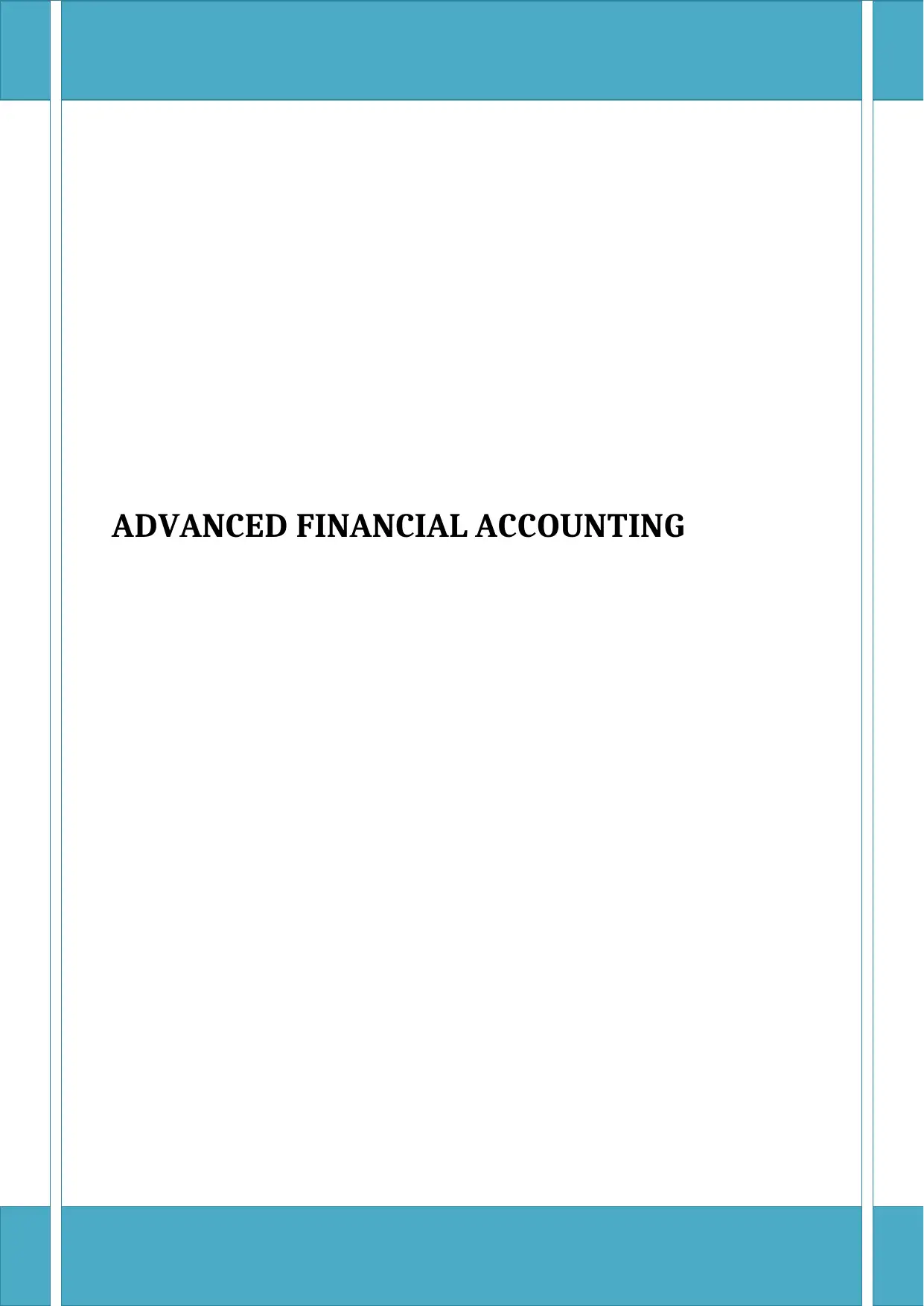
ADVANCED FINANCIAL ACCOUNTING
Paraphrase This Document
Need a fresh take? Get an instant paraphrase of this document with our AI Paraphraser
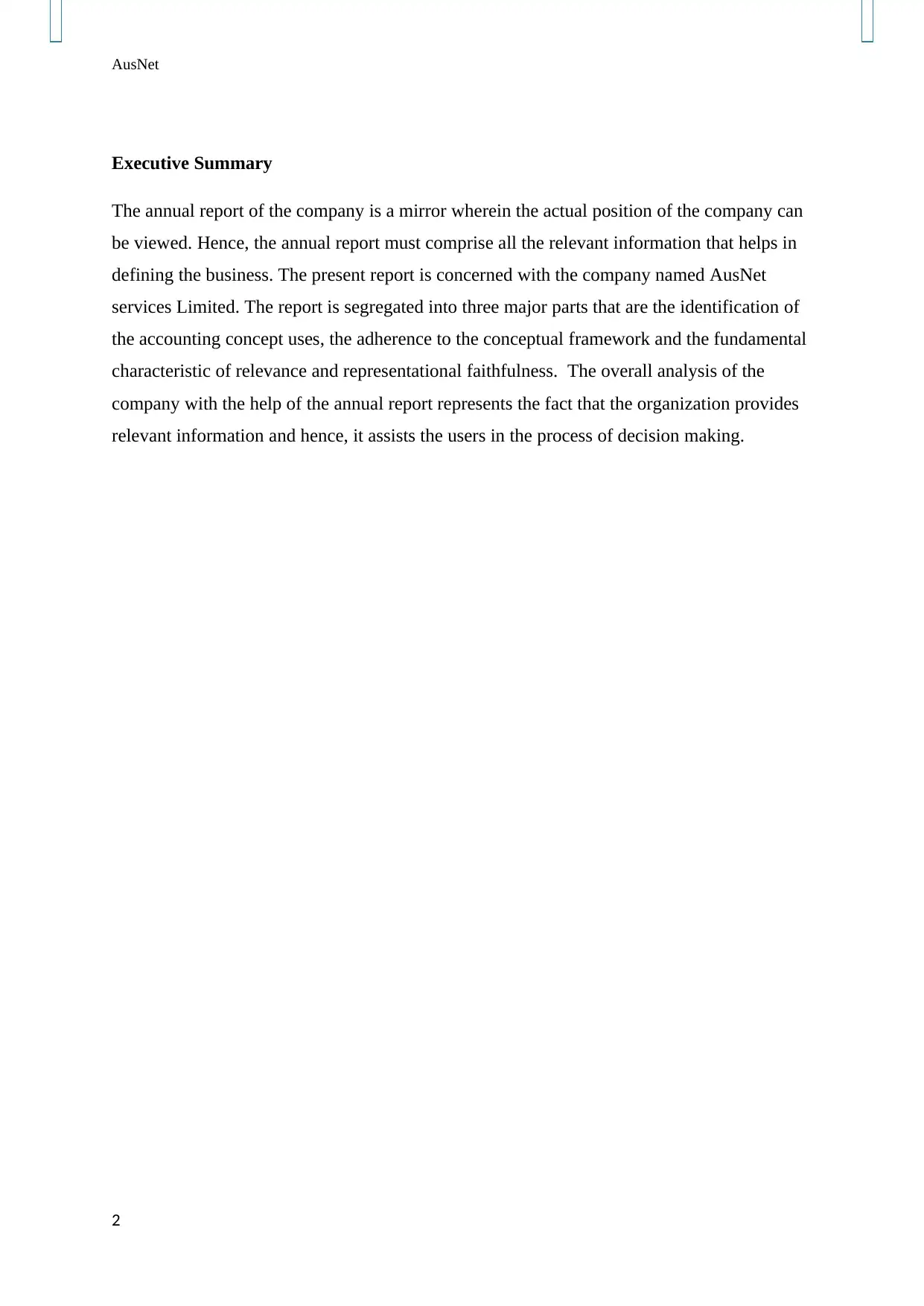
AusNet
Executive Summary
The annual report of the company is a mirror wherein the actual position of the company can
be viewed. Hence, the annual report must comprise all the relevant information that helps in
defining the business. The present report is concerned with the company named AusNet
services Limited. The report is segregated into three major parts that are the identification of
the accounting concept uses, the adherence to the conceptual framework and the fundamental
characteristic of relevance and representational faithfulness. The overall analysis of the
company with the help of the annual report represents the fact that the organization provides
relevant information and hence, it assists the users in the process of decision making.
2
Executive Summary
The annual report of the company is a mirror wherein the actual position of the company can
be viewed. Hence, the annual report must comprise all the relevant information that helps in
defining the business. The present report is concerned with the company named AusNet
services Limited. The report is segregated into three major parts that are the identification of
the accounting concept uses, the adherence to the conceptual framework and the fundamental
characteristic of relevance and representational faithfulness. The overall analysis of the
company with the help of the annual report represents the fact that the organization provides
relevant information and hence, it assists the users in the process of decision making.
2

AusNet
Contents
Introduction...........................................................................................................................................4
1. Accounting concepts that were used..............................................................................................4
2. Measurement issue with an example...............................................................................................5
3. Relevance and representational faithfulness....................................................................................6
Conclusion.............................................................................................................................................9
References...........................................................................................................................................10
3
Contents
Introduction...........................................................................................................................................4
1. Accounting concepts that were used..............................................................................................4
2. Measurement issue with an example...............................................................................................5
3. Relevance and representational faithfulness....................................................................................6
Conclusion.............................................................................................................................................9
References...........................................................................................................................................10
3
⊘ This is a preview!⊘
Do you want full access?
Subscribe today to unlock all pages.

Trusted by 1+ million students worldwide

AusNet
Introduction
AusNet Services is an Australian company that currently owns and operates electricity and
gas network resources worth not less than AUS $11 billion. The Australian company is into
the distribution of gas and electricity resources and has a consumer base of at least 1.4
million (AusNet., 2018). The company has a total workforce of around 1,900 personnel at
present. The company aims at the preservation of natural resources and for this purpose, the
same has taken necessary initiatives by allowing its consumers to regulate their overall
energy usage. AusNet Services preaches its consumers and therefore, keeps their wellness as
a priority always (AusNet., 2018).
The Board approved the consolidated financial statements of the aforesaid company and its
subsidiaries on May 13, 2018. These statements were projected in Australian dollars and
were developed by a for-profit company. The financials of the company were made in full
adherence to all the necessary accounting standards. As per the business activities and the
financial performance of the AusNet Services, it can be said that the company has a long way
to go and it is most likely to accomplish all its long term goals. The company has cash in
hand of $658.2 million and bank debt of around $545.5 million as of March 31, 2018
(AusNet., 2018). The future of the AusNet Services seems really bright and the company
shall continue to rise and shine in the same way if it chooses to operate ethically just like the
way it has been doing all this time.
1. Accounting concepts that were used
There are various concepts used for accounting purposes. However, there are certain concepts
that are the basis of accounting. These are consistency, the principle of objectivity, matching,
and revenue recognition.
The financials of an organization must always reflect the utmost transparency. The
facilitation of transparency in the financial statements of an organization will always ensure
that there is a representation of the true and fair view of its actual state of affairs. The
principle of objectivity is a very important accounting concept. It not only benefits the
readers of the financial statements but also benefits the organization in the long-term. The
management of an entity must always ensure that the financials of the same are prepared
ethically and there is a clear projection of the true and fair view of its actual well being. The
4
Introduction
AusNet Services is an Australian company that currently owns and operates electricity and
gas network resources worth not less than AUS $11 billion. The Australian company is into
the distribution of gas and electricity resources and has a consumer base of at least 1.4
million (AusNet., 2018). The company has a total workforce of around 1,900 personnel at
present. The company aims at the preservation of natural resources and for this purpose, the
same has taken necessary initiatives by allowing its consumers to regulate their overall
energy usage. AusNet Services preaches its consumers and therefore, keeps their wellness as
a priority always (AusNet., 2018).
The Board approved the consolidated financial statements of the aforesaid company and its
subsidiaries on May 13, 2018. These statements were projected in Australian dollars and
were developed by a for-profit company. The financials of the company were made in full
adherence to all the necessary accounting standards. As per the business activities and the
financial performance of the AusNet Services, it can be said that the company has a long way
to go and it is most likely to accomplish all its long term goals. The company has cash in
hand of $658.2 million and bank debt of around $545.5 million as of March 31, 2018
(AusNet., 2018). The future of the AusNet Services seems really bright and the company
shall continue to rise and shine in the same way if it chooses to operate ethically just like the
way it has been doing all this time.
1. Accounting concepts that were used
There are various concepts used for accounting purposes. However, there are certain concepts
that are the basis of accounting. These are consistency, the principle of objectivity, matching,
and revenue recognition.
The financials of an organization must always reflect the utmost transparency. The
facilitation of transparency in the financial statements of an organization will always ensure
that there is a representation of the true and fair view of its actual state of affairs. The
principle of objectivity is a very important accounting concept. It not only benefits the
readers of the financial statements but also benefits the organization in the long-term. The
management of an entity must always ensure that the financials of the same are prepared
ethically and there is a clear projection of the true and fair view of its actual well being. The
4
Paraphrase This Document
Need a fresh take? Get an instant paraphrase of this document with our AI Paraphraser

AusNet
objectivity of the financial statements of an entity is entirely in the hands of the management.
It is the responsibility of the management to make sure that the financials of the company
bears the principle of objectivity that is absolute rightness and is free from any material
misstatements. The financial statements of an organization are prepared by the management
of the same and then audited by the audit team so that the presence of any incorrect
information or material misstatements can be detected and eliminated.
The costs borne by an organization with respect to various activities such as production,
marketing, sales, and distribution must be backed up with the revenues earned. This is what
the matching concept is all about. There are various types of costs borne in AusNet Services.
The company treats its costs in either of the two ways based on its ability to generate
revenues. If the costs incurred are about to generate revenues to the company in the future,
then these costs are presented in its balance sheet and if these costs are able to generate
revenues to the company in the ongoing period, then these are treated as an expense in its
Income Statement (AusNet., 2018).
The revenue recognition concept is used in order to disclose information pertaining to
revenue recognition. From the annual report of AusNet Services, it can be seen that the
company follows AASB 15. AASB 15 offers a five-step model that must be used as criteria
for revenue recognition with consumers. Therefore, the company follows criteria with respect
to costs of procuring and completion of a contract, transfer of risks and rewards of ownership,
and accounting for variable consideration.
The principle of consistency is a very essential concept in accountancy. The concept is all
about maintaining consistency in providing adequate disclosure of information in the
company’s financials every year and the same is observed in the case of AusNet. It allow the
users of the financial statements to be able to draw comparisons over different years
pertaining to the performance of different parameters. Using one method for calculation of
results in one year and opting for another method in another year will not only impact the
results but will also disallow the users of the financial statements to understand the real status
of the company. Therefore, the company must maintain consistency in the use of methods in
their statements so as to guide the users in deriving an appropriate understanding of the
wellness of the same. As seen for AusNet, the accounting concept that is the principle of
consistency helps the users to the annual report display the correct information and enables
comparison.
5
objectivity of the financial statements of an entity is entirely in the hands of the management.
It is the responsibility of the management to make sure that the financials of the company
bears the principle of objectivity that is absolute rightness and is free from any material
misstatements. The financial statements of an organization are prepared by the management
of the same and then audited by the audit team so that the presence of any incorrect
information or material misstatements can be detected and eliminated.
The costs borne by an organization with respect to various activities such as production,
marketing, sales, and distribution must be backed up with the revenues earned. This is what
the matching concept is all about. There are various types of costs borne in AusNet Services.
The company treats its costs in either of the two ways based on its ability to generate
revenues. If the costs incurred are about to generate revenues to the company in the future,
then these costs are presented in its balance sheet and if these costs are able to generate
revenues to the company in the ongoing period, then these are treated as an expense in its
Income Statement (AusNet., 2018).
The revenue recognition concept is used in order to disclose information pertaining to
revenue recognition. From the annual report of AusNet Services, it can be seen that the
company follows AASB 15. AASB 15 offers a five-step model that must be used as criteria
for revenue recognition with consumers. Therefore, the company follows criteria with respect
to costs of procuring and completion of a contract, transfer of risks and rewards of ownership,
and accounting for variable consideration.
The principle of consistency is a very essential concept in accountancy. The concept is all
about maintaining consistency in providing adequate disclosure of information in the
company’s financials every year and the same is observed in the case of AusNet. It allow the
users of the financial statements to be able to draw comparisons over different years
pertaining to the performance of different parameters. Using one method for calculation of
results in one year and opting for another method in another year will not only impact the
results but will also disallow the users of the financial statements to understand the real status
of the company. Therefore, the company must maintain consistency in the use of methods in
their statements so as to guide the users in deriving an appropriate understanding of the
wellness of the same. As seen for AusNet, the accounting concept that is the principle of
consistency helps the users to the annual report display the correct information and enables
comparison.
5
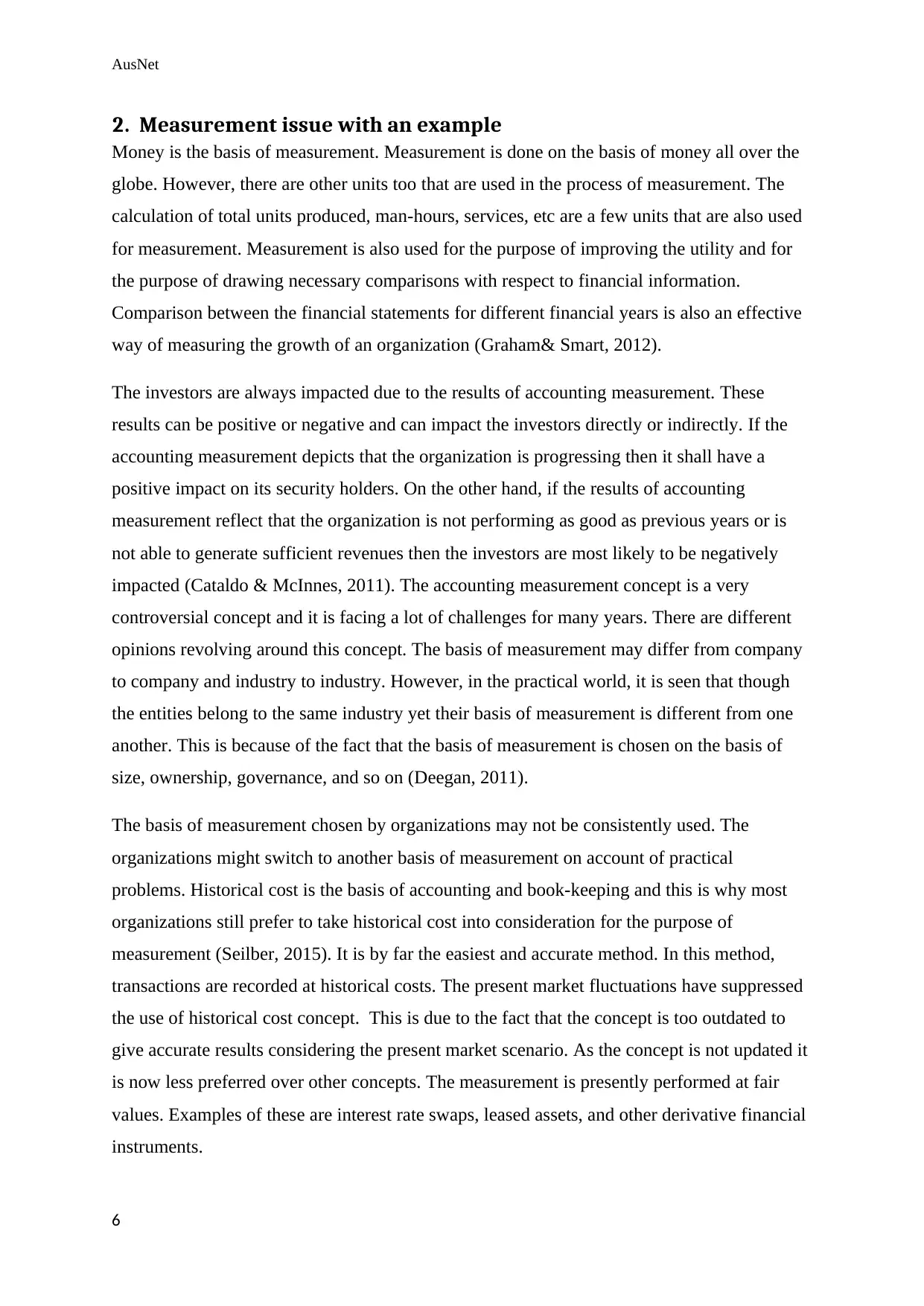
AusNet
2. Measurement issue with an example
Money is the basis of measurement. Measurement is done on the basis of money all over the
globe. However, there are other units too that are used in the process of measurement. The
calculation of total units produced, man-hours, services, etc are a few units that are also used
for measurement. Measurement is also used for the purpose of improving the utility and for
the purpose of drawing necessary comparisons with respect to financial information.
Comparison between the financial statements for different financial years is also an effective
way of measuring the growth of an organization (Graham& Smart, 2012).
The investors are always impacted due to the results of accounting measurement. These
results can be positive or negative and can impact the investors directly or indirectly. If the
accounting measurement depicts that the organization is progressing then it shall have a
positive impact on its security holders. On the other hand, if the results of accounting
measurement reflect that the organization is not performing as good as previous years or is
not able to generate sufficient revenues then the investors are most likely to be negatively
impacted (Cataldo & McInnes, 2011). The accounting measurement concept is a very
controversial concept and it is facing a lot of challenges for many years. There are different
opinions revolving around this concept. The basis of measurement may differ from company
to company and industry to industry. However, in the practical world, it is seen that though
the entities belong to the same industry yet their basis of measurement is different from one
another. This is because of the fact that the basis of measurement is chosen on the basis of
size, ownership, governance, and so on (Deegan, 2011).
The basis of measurement chosen by organizations may not be consistently used. The
organizations might switch to another basis of measurement on account of practical
problems. Historical cost is the basis of accounting and book-keeping and this is why most
organizations still prefer to take historical cost into consideration for the purpose of
measurement (Seilber, 2015). It is by far the easiest and accurate method. In this method,
transactions are recorded at historical costs. The present market fluctuations have suppressed
the use of historical cost concept. This is due to the fact that the concept is too outdated to
give accurate results considering the present market scenario. As the concept is not updated it
is now less preferred over other concepts. The measurement is presently performed at fair
values. Examples of these are interest rate swaps, leased assets, and other derivative financial
instruments.
6
2. Measurement issue with an example
Money is the basis of measurement. Measurement is done on the basis of money all over the
globe. However, there are other units too that are used in the process of measurement. The
calculation of total units produced, man-hours, services, etc are a few units that are also used
for measurement. Measurement is also used for the purpose of improving the utility and for
the purpose of drawing necessary comparisons with respect to financial information.
Comparison between the financial statements for different financial years is also an effective
way of measuring the growth of an organization (Graham& Smart, 2012).
The investors are always impacted due to the results of accounting measurement. These
results can be positive or negative and can impact the investors directly or indirectly. If the
accounting measurement depicts that the organization is progressing then it shall have a
positive impact on its security holders. On the other hand, if the results of accounting
measurement reflect that the organization is not performing as good as previous years or is
not able to generate sufficient revenues then the investors are most likely to be negatively
impacted (Cataldo & McInnes, 2011). The accounting measurement concept is a very
controversial concept and it is facing a lot of challenges for many years. There are different
opinions revolving around this concept. The basis of measurement may differ from company
to company and industry to industry. However, in the practical world, it is seen that though
the entities belong to the same industry yet their basis of measurement is different from one
another. This is because of the fact that the basis of measurement is chosen on the basis of
size, ownership, governance, and so on (Deegan, 2011).
The basis of measurement chosen by organizations may not be consistently used. The
organizations might switch to another basis of measurement on account of practical
problems. Historical cost is the basis of accounting and book-keeping and this is why most
organizations still prefer to take historical cost into consideration for the purpose of
measurement (Seilber, 2015). It is by far the easiest and accurate method. In this method,
transactions are recorded at historical costs. The present market fluctuations have suppressed
the use of historical cost concept. This is due to the fact that the concept is too outdated to
give accurate results considering the present market scenario. As the concept is not updated it
is now less preferred over other concepts. The measurement is presently performed at fair
values. Examples of these are interest rate swaps, leased assets, and other derivative financial
instruments.
6
⊘ This is a preview!⊘
Do you want full access?
Subscribe today to unlock all pages.

Trusted by 1+ million students worldwide
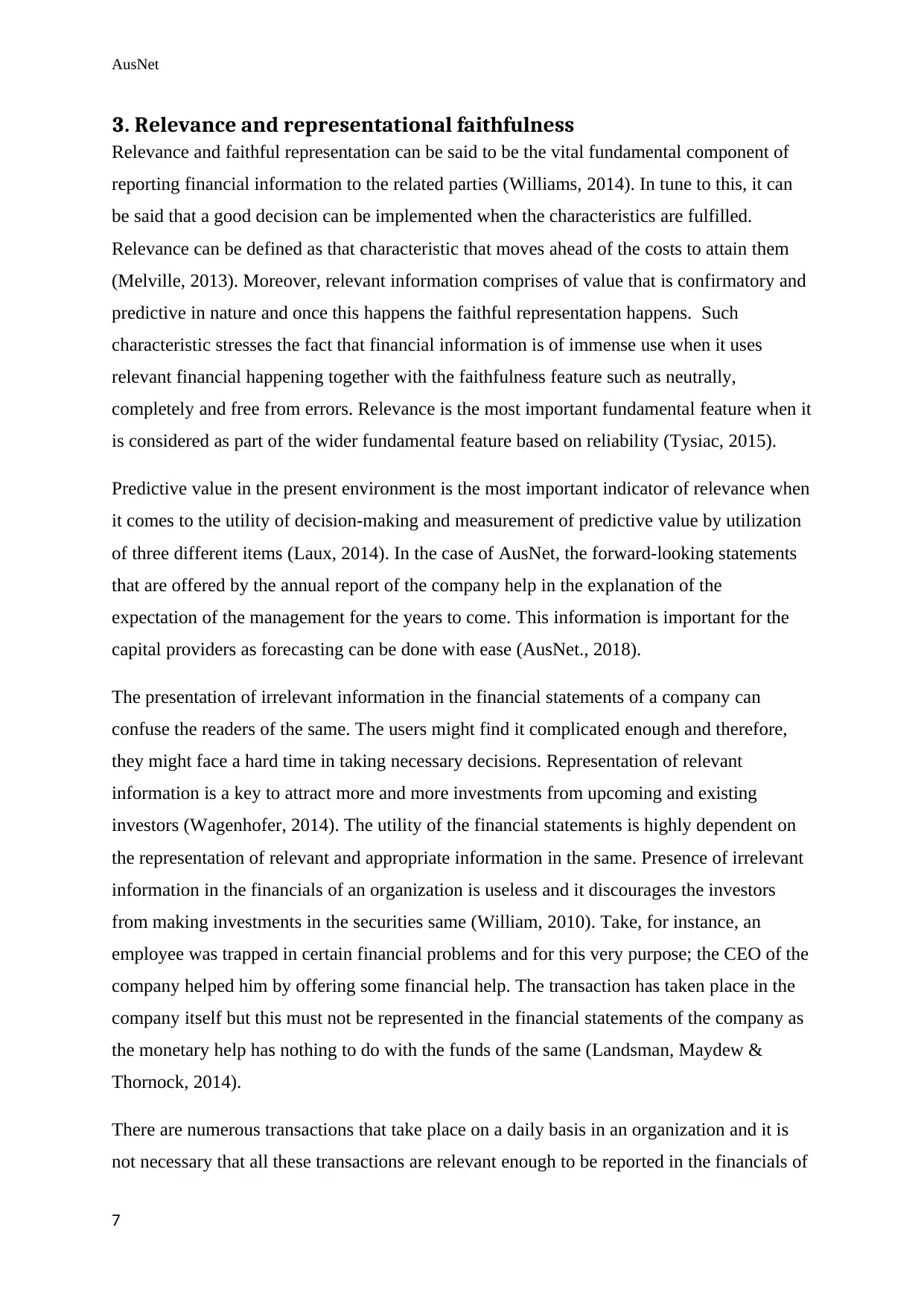
AusNet
3. Relevance and representational faithfulness
Relevance and faithful representation can be said to be the vital fundamental component of
reporting financial information to the related parties (Williams, 2014). In tune to this, it can
be said that a good decision can be implemented when the characteristics are fulfilled.
Relevance can be defined as that characteristic that moves ahead of the costs to attain them
(Melville, 2013). Moreover, relevant information comprises of value that is confirmatory and
predictive in nature and once this happens the faithful representation happens. Such
characteristic stresses the fact that financial information is of immense use when it uses
relevant financial happening together with the faithfulness feature such as neutrally,
completely and free from errors. Relevance is the most important fundamental feature when it
is considered as part of the wider fundamental feature based on reliability (Tysiac, 2015).
Predictive value in the present environment is the most important indicator of relevance when
it comes to the utility of decision-making and measurement of predictive value by utilization
of three different items (Laux, 2014). In the case of AusNet, the forward-looking statements
that are offered by the annual report of the company help in the explanation of the
expectation of the management for the years to come. This information is important for the
capital providers as forecasting can be done with ease (AusNet., 2018).
The presentation of irrelevant information in the financial statements of a company can
confuse the readers of the same. The users might find it complicated enough and therefore,
they might face a hard time in taking necessary decisions. Representation of relevant
information is a key to attract more and more investments from upcoming and existing
investors (Wagenhofer, 2014). The utility of the financial statements is highly dependent on
the representation of relevant and appropriate information in the same. Presence of irrelevant
information in the financials of an organization is useless and it discourages the investors
from making investments in the securities same (William, 2010). Take, for instance, an
employee was trapped in certain financial problems and for this very purpose; the CEO of the
company helped him by offering some financial help. The transaction has taken place in the
company itself but this must not be represented in the financial statements of the company as
the monetary help has nothing to do with the funds of the same (Landsman, Maydew &
Thornock, 2014).
There are numerous transactions that take place on a daily basis in an organization and it is
not necessary that all these transactions are relevant enough to be reported in the financials of
7
3. Relevance and representational faithfulness
Relevance and faithful representation can be said to be the vital fundamental component of
reporting financial information to the related parties (Williams, 2014). In tune to this, it can
be said that a good decision can be implemented when the characteristics are fulfilled.
Relevance can be defined as that characteristic that moves ahead of the costs to attain them
(Melville, 2013). Moreover, relevant information comprises of value that is confirmatory and
predictive in nature and once this happens the faithful representation happens. Such
characteristic stresses the fact that financial information is of immense use when it uses
relevant financial happening together with the faithfulness feature such as neutrally,
completely and free from errors. Relevance is the most important fundamental feature when it
is considered as part of the wider fundamental feature based on reliability (Tysiac, 2015).
Predictive value in the present environment is the most important indicator of relevance when
it comes to the utility of decision-making and measurement of predictive value by utilization
of three different items (Laux, 2014). In the case of AusNet, the forward-looking statements
that are offered by the annual report of the company help in the explanation of the
expectation of the management for the years to come. This information is important for the
capital providers as forecasting can be done with ease (AusNet., 2018).
The presentation of irrelevant information in the financial statements of a company can
confuse the readers of the same. The users might find it complicated enough and therefore,
they might face a hard time in taking necessary decisions. Representation of relevant
information is a key to attract more and more investments from upcoming and existing
investors (Wagenhofer, 2014). The utility of the financial statements is highly dependent on
the representation of relevant and appropriate information in the same. Presence of irrelevant
information in the financials of an organization is useless and it discourages the investors
from making investments in the securities same (William, 2010). Take, for instance, an
employee was trapped in certain financial problems and for this very purpose; the CEO of the
company helped him by offering some financial help. The transaction has taken place in the
company itself but this must not be represented in the financial statements of the company as
the monetary help has nothing to do with the funds of the same (Landsman, Maydew &
Thornock, 2014).
There are numerous transactions that take place on a daily basis in an organization and it is
not necessary that all these transactions are relevant enough to be reported in the financials of
7
Paraphrase This Document
Need a fresh take? Get an instant paraphrase of this document with our AI Paraphraser
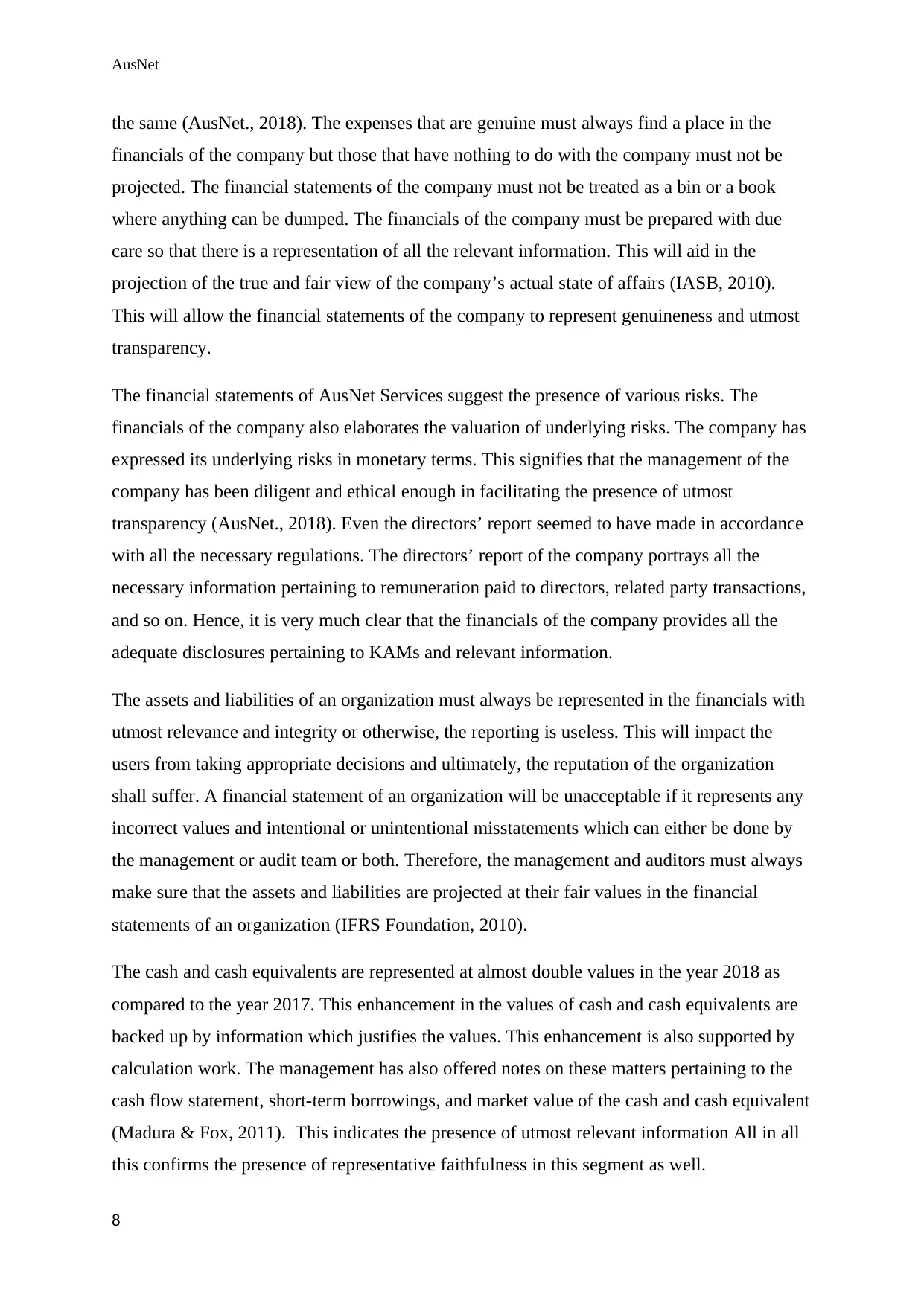
AusNet
the same (AusNet., 2018). The expenses that are genuine must always find a place in the
financials of the company but those that have nothing to do with the company must not be
projected. The financial statements of the company must not be treated as a bin or a book
where anything can be dumped. The financials of the company must be prepared with due
care so that there is a representation of all the relevant information. This will aid in the
projection of the true and fair view of the company’s actual state of affairs (IASB, 2010).
This will allow the financial statements of the company to represent genuineness and utmost
transparency.
The financial statements of AusNet Services suggest the presence of various risks. The
financials of the company also elaborates the valuation of underlying risks. The company has
expressed its underlying risks in monetary terms. This signifies that the management of the
company has been diligent and ethical enough in facilitating the presence of utmost
transparency (AusNet., 2018). Even the directors’ report seemed to have made in accordance
with all the necessary regulations. The directors’ report of the company portrays all the
necessary information pertaining to remuneration paid to directors, related party transactions,
and so on. Hence, it is very much clear that the financials of the company provides all the
adequate disclosures pertaining to KAMs and relevant information.
The assets and liabilities of an organization must always be represented in the financials with
utmost relevance and integrity or otherwise, the reporting is useless. This will impact the
users from taking appropriate decisions and ultimately, the reputation of the organization
shall suffer. A financial statement of an organization will be unacceptable if it represents any
incorrect values and intentional or unintentional misstatements which can either be done by
the management or audit team or both. Therefore, the management and auditors must always
make sure that the assets and liabilities are projected at their fair values in the financial
statements of an organization (IFRS Foundation, 2010).
The cash and cash equivalents are represented at almost double values in the year 2018 as
compared to the year 2017. This enhancement in the values of cash and cash equivalents are
backed up by information which justifies the values. This enhancement is also supported by
calculation work. The management has also offered notes on these matters pertaining to the
cash flow statement, short-term borrowings, and market value of the cash and cash equivalent
(Madura & Fox, 2011). This indicates the presence of utmost relevant information All in all
this confirms the presence of representative faithfulness in this segment as well.
8
the same (AusNet., 2018). The expenses that are genuine must always find a place in the
financials of the company but those that have nothing to do with the company must not be
projected. The financial statements of the company must not be treated as a bin or a book
where anything can be dumped. The financials of the company must be prepared with due
care so that there is a representation of all the relevant information. This will aid in the
projection of the true and fair view of the company’s actual state of affairs (IASB, 2010).
This will allow the financial statements of the company to represent genuineness and utmost
transparency.
The financial statements of AusNet Services suggest the presence of various risks. The
financials of the company also elaborates the valuation of underlying risks. The company has
expressed its underlying risks in monetary terms. This signifies that the management of the
company has been diligent and ethical enough in facilitating the presence of utmost
transparency (AusNet., 2018). Even the directors’ report seemed to have made in accordance
with all the necessary regulations. The directors’ report of the company portrays all the
necessary information pertaining to remuneration paid to directors, related party transactions,
and so on. Hence, it is very much clear that the financials of the company provides all the
adequate disclosures pertaining to KAMs and relevant information.
The assets and liabilities of an organization must always be represented in the financials with
utmost relevance and integrity or otherwise, the reporting is useless. This will impact the
users from taking appropriate decisions and ultimately, the reputation of the organization
shall suffer. A financial statement of an organization will be unacceptable if it represents any
incorrect values and intentional or unintentional misstatements which can either be done by
the management or audit team or both. Therefore, the management and auditors must always
make sure that the assets and liabilities are projected at their fair values in the financial
statements of an organization (IFRS Foundation, 2010).
The cash and cash equivalents are represented at almost double values in the year 2018 as
compared to the year 2017. This enhancement in the values of cash and cash equivalents are
backed up by information which justifies the values. This enhancement is also supported by
calculation work. The management has also offered notes on these matters pertaining to the
cash flow statement, short-term borrowings, and market value of the cash and cash equivalent
(Madura & Fox, 2011). This indicates the presence of utmost relevant information All in all
this confirms the presence of representative faithfulness in this segment as well.
8

AusNet
The financials of the company also provides adequate disclosures pertaining to all the
policies and regulations for the valuation of its liabilities. This signifies the presence of
representational faithfulness. The relevance of the information provided with respect to the
valuation of liabilities is commendable.
Conclusion
From the annual report of Ausnet, it can be seen that there was an increment in the FV
technique that involves huge valuation and is a challenge to the accountants to tackle.
Moreover, any change in the accounting standard can have major implications for an
organization. To conclude it can be said that the financial statements of AusNet Services
offers all the relevant information and signifies the presence of representational faithfulness.
This shall ultimately benefit the readers of the financial statements as they can easily
construct the decisions pertaining to investments without a second thought or doubt. The
enhancement in cash and cash equivalents is too appropriately addressed and justified in the
financials of the company which makes it believable and the credibility of the same cannot be
questioned. The information on the assets and liabilities of the company were also
represented with full relevance. All in all the financial statements of the company signifies
the presence of representational faithfulness.
9
The financials of the company also provides adequate disclosures pertaining to all the
policies and regulations for the valuation of its liabilities. This signifies the presence of
representational faithfulness. The relevance of the information provided with respect to the
valuation of liabilities is commendable.
Conclusion
From the annual report of Ausnet, it can be seen that there was an increment in the FV
technique that involves huge valuation and is a challenge to the accountants to tackle.
Moreover, any change in the accounting standard can have major implications for an
organization. To conclude it can be said that the financial statements of AusNet Services
offers all the relevant information and signifies the presence of representational faithfulness.
This shall ultimately benefit the readers of the financial statements as they can easily
construct the decisions pertaining to investments without a second thought or doubt. The
enhancement in cash and cash equivalents is too appropriately addressed and justified in the
financials of the company which makes it believable and the credibility of the same cannot be
questioned. The information on the assets and liabilities of the company were also
represented with full relevance. All in all the financial statements of the company signifies
the presence of representational faithfulness.
9
⊘ This is a preview!⊘
Do you want full access?
Subscribe today to unlock all pages.

Trusted by 1+ million students worldwide

AusNet
References
AusNet. (2018) AusNet 2018 annual report & accounts. Available from:
file:///C:/Users/HP/Documents/Academic%20writing/2019/Nerdy/MAy/797381/2018%20An
nual%20Report.pdf [Accessed 26 May 2019]
Cataldo, J.M and McInnes, J.M. (2011) The Accounting Identity and the Identity of
Accountants: Accounting's Competing Paradigms through the Prism of Professional Practice.
Accounting and the Public Interest, 11(1), 116-129. Available from:
https://doi.org/10.2308/apin-10122 [Accessed 26 May 2019]
Deegan, C. M. (2011) In Financial accounting theory. North Ryde, N.S.W: McGraw-Hill
Graham, J & Smart, S . (2012) Introduction to corporate finance. Australia: South-Western
Cengage Learning.
https://doi.org/10.1080/00014788.2014.897867 [Accessed 26 May 2019]
IASB. (2010) The Conceptual Framework for Financial Reporting. Available from
http://eifrs.ifrs.org. [Accessed 26 May 2019]
IFRS Foundation. (2010). Conceptual Framework for Financial Reporting 2010. Available
from: http://www.ifrs.org/News/Press-Releases/Documents/ConceptualFW2010vb.pdf
[Accessed 26 May 2019]
Landsman, W. R, Maydew, E. L & Thornock, J. R. (2014) The information content of annual
earnings announcements and mandatory adoption of IFRS. Journal of Accounting and
Economics, 53, 34-54. Available from : http://papers.ssrn.com/sol3/papers.cfm?
abstract_id=1337567 [Accessed 26 May 2019]
Laux, B. (2014) Discussion of The role of revenue recognition in performance reporting’,
Accounting and Business Research, 44(4), 380-382. Available from :
Madura, R., & Fox, J. (2011). International financial management (2nd ed.). South Western
Melville, A. (2013) International Financial Reporting – A Practical Guide, 4th edition,
Pearson, Education Limited, UK
Needles, B.E & Powers, M. (2013) Principles of Financial Accounting. Financial Accounting
10
References
AusNet. (2018) AusNet 2018 annual report & accounts. Available from:
file:///C:/Users/HP/Documents/Academic%20writing/2019/Nerdy/MAy/797381/2018%20An
nual%20Report.pdf [Accessed 26 May 2019]
Cataldo, J.M and McInnes, J.M. (2011) The Accounting Identity and the Identity of
Accountants: Accounting's Competing Paradigms through the Prism of Professional Practice.
Accounting and the Public Interest, 11(1), 116-129. Available from:
https://doi.org/10.2308/apin-10122 [Accessed 26 May 2019]
Deegan, C. M. (2011) In Financial accounting theory. North Ryde, N.S.W: McGraw-Hill
Graham, J & Smart, S . (2012) Introduction to corporate finance. Australia: South-Western
Cengage Learning.
https://doi.org/10.1080/00014788.2014.897867 [Accessed 26 May 2019]
IASB. (2010) The Conceptual Framework for Financial Reporting. Available from
http://eifrs.ifrs.org. [Accessed 26 May 2019]
IFRS Foundation. (2010). Conceptual Framework for Financial Reporting 2010. Available
from: http://www.ifrs.org/News/Press-Releases/Documents/ConceptualFW2010vb.pdf
[Accessed 26 May 2019]
Landsman, W. R, Maydew, E. L & Thornock, J. R. (2014) The information content of annual
earnings announcements and mandatory adoption of IFRS. Journal of Accounting and
Economics, 53, 34-54. Available from : http://papers.ssrn.com/sol3/papers.cfm?
abstract_id=1337567 [Accessed 26 May 2019]
Laux, B. (2014) Discussion of The role of revenue recognition in performance reporting’,
Accounting and Business Research, 44(4), 380-382. Available from :
Madura, R., & Fox, J. (2011). International financial management (2nd ed.). South Western
Melville, A. (2013) International Financial Reporting – A Practical Guide, 4th edition,
Pearson, Education Limited, UK
Needles, B.E & Powers, M. (2013) Principles of Financial Accounting. Financial Accounting
10
Paraphrase This Document
Need a fresh take? Get an instant paraphrase of this document with our AI Paraphraser
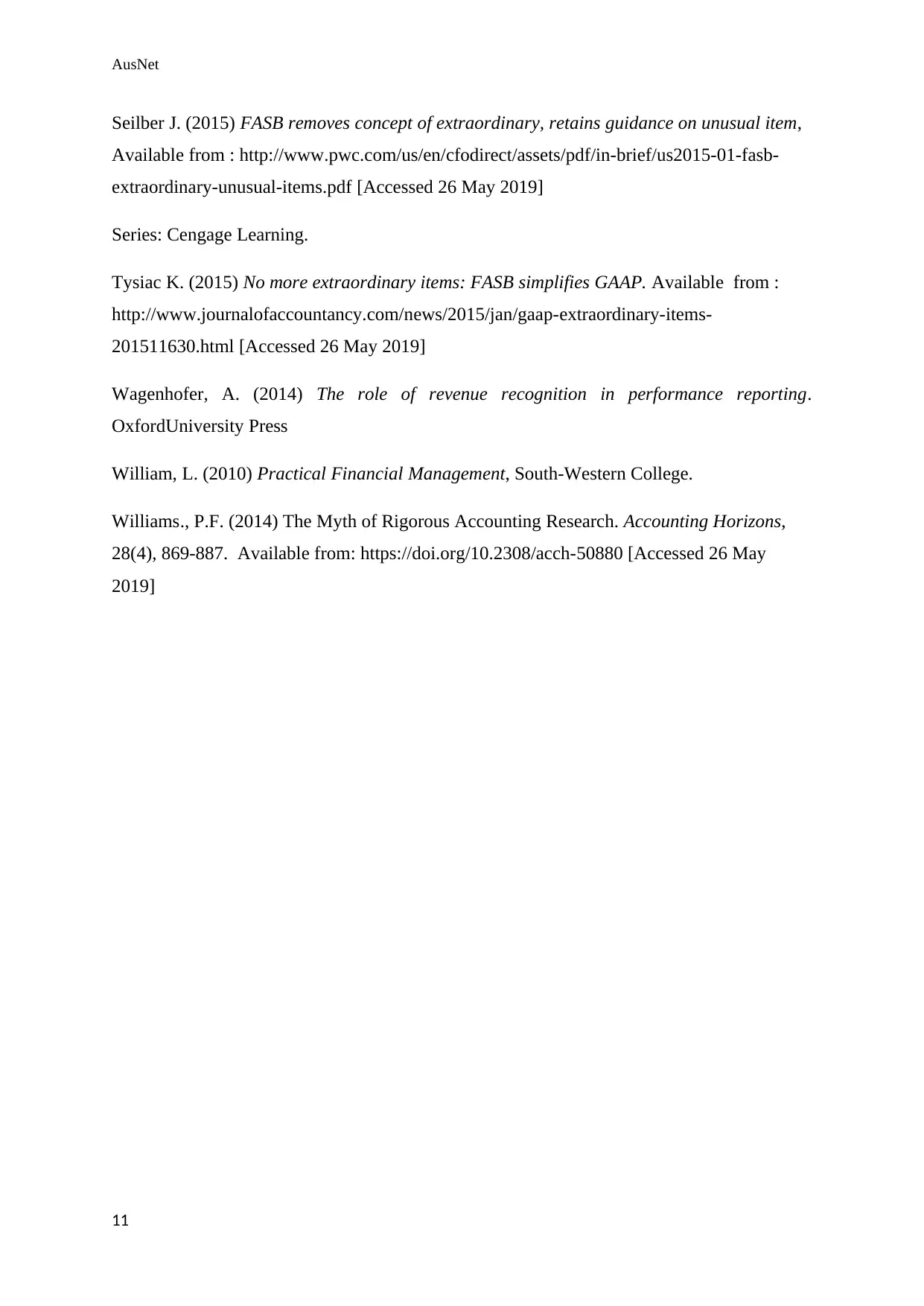
AusNet
Seilber J. (2015) FASB removes concept of extraordinary, retains guidance on unusual item,
Available from : http://www.pwc.com/us/en/cfodirect/assets/pdf/in-brief/us2015-01-fasb-
extraordinary-unusual-items.pdf [Accessed 26 May 2019]
Series: Cengage Learning.
Tysiac K. (2015) No more extraordinary items: FASB simplifies GAAP. Available from :
http://www.journalofaccountancy.com/news/2015/jan/gaap-extraordinary-items-
201511630.html [Accessed 26 May 2019]
Wagenhofer, A. (2014) The role of revenue recognition in performance reporting.
OxfordUniversity Press
William, L. (2010) Practical Financial Management, South-Western College.
Williams., P.F. (2014) The Myth of Rigorous Accounting Research. Accounting Horizons,
28(4), 869-887. Available from: https://doi.org/10.2308/acch-50880 [Accessed 26 May
2019]
11
Seilber J. (2015) FASB removes concept of extraordinary, retains guidance on unusual item,
Available from : http://www.pwc.com/us/en/cfodirect/assets/pdf/in-brief/us2015-01-fasb-
extraordinary-unusual-items.pdf [Accessed 26 May 2019]
Series: Cengage Learning.
Tysiac K. (2015) No more extraordinary items: FASB simplifies GAAP. Available from :
http://www.journalofaccountancy.com/news/2015/jan/gaap-extraordinary-items-
201511630.html [Accessed 26 May 2019]
Wagenhofer, A. (2014) The role of revenue recognition in performance reporting.
OxfordUniversity Press
William, L. (2010) Practical Financial Management, South-Western College.
Williams., P.F. (2014) The Myth of Rigorous Accounting Research. Accounting Horizons,
28(4), 869-887. Available from: https://doi.org/10.2308/acch-50880 [Accessed 26 May
2019]
11
1 out of 11
Related Documents
Your All-in-One AI-Powered Toolkit for Academic Success.
+13062052269
info@desklib.com
Available 24*7 on WhatsApp / Email
![[object Object]](/_next/static/media/star-bottom.7253800d.svg)
Unlock your academic potential
Copyright © 2020–2025 A2Z Services. All Rights Reserved. Developed and managed by ZUCOL.




